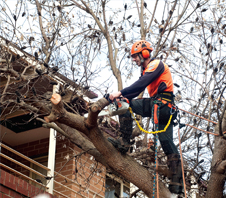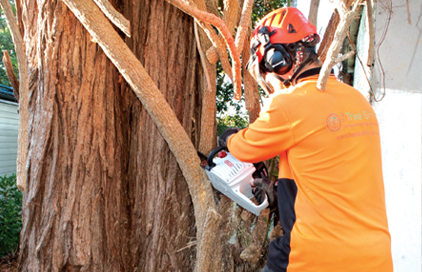 We have had our fair share of sun crazy hot days and dry weather lately and, I have to say, I am well looking forward to winter.
We have had our fair share of sun crazy hot days and dry weather lately and, I have to say, I am well looking forward to winter.
I was thinking about pending storms, response crews and some of the general chainsaw operation and maintenance standards that we are identifying during regular training and assessment sessions.
We constantly discover during our regular assessment and refresher courses in chainsaw operation maintenance and tree felling – some of the so-called basic competency levels required as standard by our industry – that attention to detail and standards of sharpening chains is sadly lacking.
It would seem that most chainsaw operators do not use any form of file guide or depth gauge setting tool when sharpening their chains because in their opinion they don’t work: “She’ll be right, mate. Just do a freehand cut!”
If you were to seek the advice of any chain manufacturer that would have spent countless dollars on developing chainsaw chain and built them to operate with an element of control and safety built in, and able to deal with trees all over the world, and then developed manuals and specific maintenance instructions to enable their performance to conform with worldwide conditions, surely it would be worth paying attention to detail and their recommendations which specify angles techniques, required tools and equipment for their maintenance.
I can freely admit that as a contractor I thought I was able to sharpen saws freestyle as well and it was not until developing my first chainsaw course (which was quite some time ago now) that I thought I would start to use some of the file guides and gadgets that are available to aid with chain sharpening.
I found that not only did all my saws cut more efficiently, but they were also much less likely to kick back, reduced the tendency to snatch and drag the chainsaw into the cut as well as the fact that the chains sprockets and guide bars actually lasted much longer. So I can honestly say that if you don’t try it, you will never know!
Note: if you have been free styling with your sharpening, it is likely that you will have sharpened too far down and into the gullet of the tooth, so that, when using the file guides for the first time, you will probably find that there is a need to file extra strokes to re-profile each tooth to its correct position; if this is not successful, then you may end up with the chain blunter than when you started; if that is the case, then you will need to file more strokes to create the correct profile or will need to consider replacing the chain and using the guides from new.
When travelling around and particularly during storm clean-up times the sight and sound of screaming chainsaws attempting to burn their way through native hardwood is not nice.
So here are a few tips on sharpening chainsaws:
- To begin you need to have some basic knowledge about the chain and its component
- The best place to start is to book a chainsaw course or attend a short refresher and update your skills at least every two years
- The operator’s manual that comes with the saw will give you a lot of the information that you will need for sharpening
- Your dealer will also carry a range of sharpening tools and equipment and will be able to recommend the correct items and file sizes to suit your chains
Parts of the Chain
- Cutters: left and right handed, these must be maintained at the correct angle and all be filed to the same length
- Top plate filing angle: found at the top part of the cutter this angle must be correctly maintained as recommended to ensure correct performance
- Side plate angle: it joins the top plate and forms the angle known as the working corner joining with the top plate
- Depth gauge: just in front of the cutting edge this regulates how far each cutter is allowed to bite into the wood; it is also considered to be one of the safety features, with its rounded front edge, which helps to reduce the risk of kickback when maintained correctly
- Tie strap and rivets: these hold the chain together and must be kept free of damage. Be aware when filing, as it is easy to file too deeply and file into them which weakens the chain
- Drive link: found on the underside of the cutters meshes with the sprocket to drive the chain around the bar; the profile of the cut away on the tang must be maintained to allow the oil to be transported around the guide bar. Be aware when filing the cutters as it is possible for the file to cut too deep into the cutter and file away part of the drive link which will cause the chain to break
You should have a dedicated toolkit to enable you to carry out chain maintenance and the following items should be carried as a minimum:
- File holders/sharpening guides that are compatible with the size and brand of chain and marked with the correct filing angles
- Suitable chainsaw round files with handles to suit the above file guides
- Fine toothed flat files for depth gauge maintenance
- Depth gauge regulating tool
- Guide bar dressing tool
- Vernier callipers to measure and ensure even cutter length
- Marker pen to mark the first cutter filed as the starting point
Your local dealer should also be able to advise on the correct tools and equipment to maintain your saw chain in the correct condition.
A blunt chain can usually be recognised from a visual inspection by the fact that it is covered with baked on tree sap or the chrome plating of the cutter is scuffed and serrated along the top plate.
If the chain becomes blunt while in use, then woodchips will become a dusty powder, cutting performance will decrease rapidly and extra pressure will need to be applied. This can be extremely dangerous as loss of control due to the extra pressure needed to make the cut can easily occur.

Blunt chains will not self-feed into the cut and may skate and bounce, which will increase the risk of kickback.
So if you find any of the above symptoms happening, then you must stop, let the bar and chain cool down and sharpen the chain.
- Make sure you have the correct size of file and guide
- Don’t handle the chain unless wearing gloves
- Check all components for excessive wear or damage
- Maintain correct filing angle
- Maintain even pressure and strokes on the file, keeping the file at the correct angle for the cutter and at 90 degrees to the bar; don’t tip it up or down
- Keep all cutters the same length; they will all enter the wood at the same height reducing vibration and one-sided cutting habits
- Remove all damage from cutters
- Check height of depth gauges using the correct gauge
- Avoid damaging other component parts of the chain
- Don’t forget to also take care of the guide bar and drive sprocket as recommended
Do not use chainsaws in the workplace unless you have been trained and assessed as competent.
At Training For Trees a comprehensive range of training assessment and refresher courses are available for operators in all areas of the arboricultural industry.
“Everyone engaged in carrying out work around trees must be trained and qualified in their designated task and strive to maintain and improve their industry currency by continuing to gain relevant experience and qualifications.”
Training is as important as the servicing of vehicles and machinery. After all, workers are the machinery that you run to operate your business. It has been proven that independent training and assessment increases safety awareness productivity and efficiency. Don’t forget to schedule in regular refresher and update training sessions.
For full trade level qualifications and apprenticeships to meet the industry standard requirement to be classified as a working arborist you will need to undertake the AHCARB30810 Certificate III in Arboriculture.
Funding incentives currently apply to eligible applicants and their employers in QLD.
“Safety Rules!”
Enrol now for Cert III Arboriculture. Contact us for your short course RPL or refresher training needs. For details go to www.trainingfortrees.com.au

